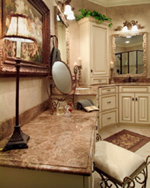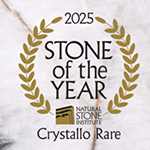Marble, Onyx, & Serpentine
Best for foyers, bathrooms, floors and hearths

Marble is a metamorphic rock found in the mountainous regions of most countries of the world. Marble quarried in India, China, Italy, and Spain represents the majority of marble, in terms of volume, that is utilized worldwide. Because of its beauty and elegance, marble is a popular choice for countertops, floors, foyers, fireplace facings and hearths, walls, and windowsills.
Marble with its inherent warmth, adds a sophisticated element to the area in which it is installed. Its naturally random appearance, engineering characteristics, and ease of maintenance makes it a premium choice for floors, wall claddings, table tops, wainscot, floors, and vanity tops. Many marbles are well suited for wet area application, which extends the versatility of this material to include tub decks and showers.
The calcite crystal is the basic building block of true marbles. The calcite crystal is vulnerable to attack by mild acids, including those commonly found in kitchen and bar settings. The user selecting marble for these applications should be aware of, and accepting of the maintenance and patina that is to be anticipated with this combination. Acid rain and other weathering elements can also affect exterior marble installations, and exterior applications are generally limited to white marbles, with some exceptions.
Often mistaken for marble is serpentine, which is actually magnesium-silicate based as opposed to calcite based. As a result of the different mineralogy and whole rock chemistry of serpentine, it exhibits greater acid resistance and abrasion resistance than does a true marble. These properties make serpentine a common choice for both kitchen counter and exterior application.
Onyx is often confused with marbles, yet it is a significantly different rock type. Onyx is a sedimentary rock, formed as stalactites and stalagmites in cave interiors. This formation method results in the cryptocrystalline construction of the rock fabric, and it is the size and uniformity of these crystals that contribute to the classic translucent property of most onyx varieties. While vulnerable to chemical and abrasive attack, the decorative appeal of onyx is perhaps unsurpassed by any other material.












